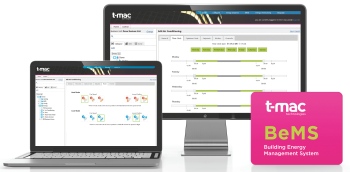People + technology = better control

Good people management and the right technology to monitor and control energy usage in buildings can enable a company to gain control of their building and see a return on investment within 18 months. Lisa Gingell of t-mac technologies explains how.
There is a lot of pressure on businesses today to keep track of the amount of energy used in their buildings in order to cut down excess use. Necessary legislative requirements such as Display Energy Certificates now shine a light on inefficient operations in under-performing buildings, so businesses today can no longer shy away from wasteful practice
In addition, under the Government’s Carbon Reduction Commitment Energy Efficiency Scheme (CRC), companies which used more than 6000 MWh of electricity in 2008 must now measure and report their carbon emissions annually.
Metering and monitoring technology plays a key role in indicating a business’s performance, but to act upon this information and control the amount of energy being used a more-thought-out strategy is needed.
So how can businesses utilise data from this technology and achieve better control of excess energy use and money at the same time? The simple answer is to obtain a centralised control platform to manage all systems and seamlessly integrate energy used within the building.
Intelligent systems like t-mac’s building energy management system (BEMS) gather data from areas such as mains electricity, HVAC and other energy-intensive equipment in a building and enable managers to access information in real-time on where energy is being used and how. Data is processed via t-mac’s energy management software, which then controls this energy use and can help reduce its impact by up to 40%.
The hardware works by monitoring energy-consumption patterns to highlight inefficiencies in use. It can verify cost savings from real-time sub-metering data, which subsequently pin-points key activities within the building that are causing unnecessary energy costs.
T-mac’s online software suite maps and logs this data and converts it into readable information. E-mail and SMS alerts can then be set up against pre-defined limits and desired settings for dedicated users — ensuring the right people are informed if these limits are exceeded.
The BEMS software also uses this process to help facilities managers adhere to legislation such as Energy Performance Certificates (EPC), DECs and the CRC.
Continuous monitoring ensures that any irregularities are spotted early — meaning maintenance issues can be dealt with before they escalate in time and cost. Such predictive maintenance not only makes it easier to pre-empt problems but also saves resources, minimises equipment down-time, reduces staff time pressures and reduces the need for expensive engineer call-outs.

While BEMS technology can make control of energy much more simple, the ‘E’ in BEMS demands a more creative control strategy — one that focuses on equipment performance and operation as well as the people that occupy the building.
The education of building occupiers is an equally important factor in any company’s energy-management strategy, as often it is the staff who forget to turn off a light or will change HVAC settings based on desire rather than need. Local HVAC controls, such as wall controls and thermostats, give power to building occupiers who may not think twice about adjusting cooling and heating for better comfort.
In winter months for example, employees that step into the office after experiencing cooler temperatures from outside are inclined to increase heating in the building in order to quickly achieve a more comfortable temperature. It is estimated that energy wastage is around 50% higher during December and January due to the inefficient control of internal climates.
Therefore, to get people to work with the control system instead of against it, building occupiers need to be informed about the underlying reasoning behind the building’s control strategy and the effect their changes will have on it in order for them to take action.
Technology can be a key driver to changing employee attitudes towards building conditions. By showcasing energy-consumption data via easy-to-read dashboard software, staff can be highlighted to the cost of inefficient use and be educated on how best to use the systems within the building.
Building energy management systems can help companies seriously slash the amount of wastage and ultimately take control of their energy consumption. But with good people management as well as the right technology, it is easy to gain control of your building and see a return on investment within 18 months.
Lisa Gingell is a director with t-mac Technologies.







